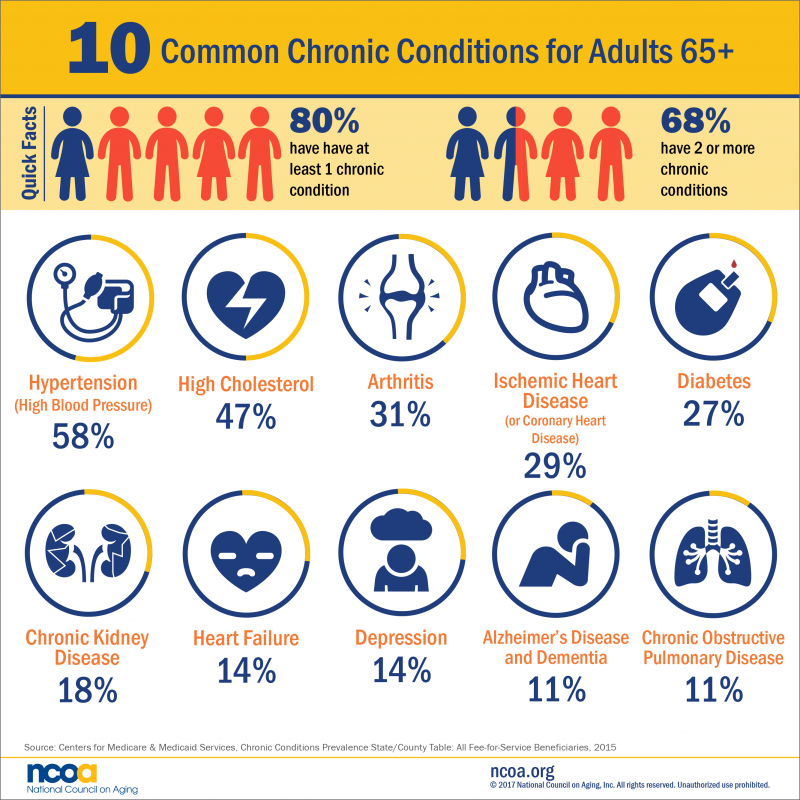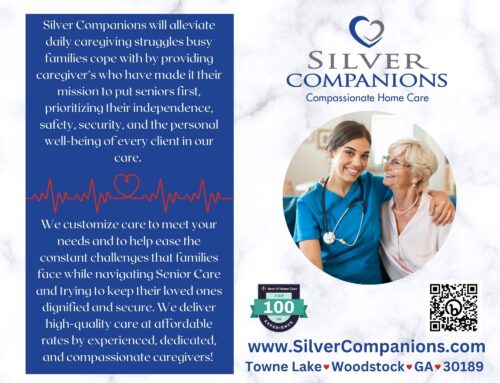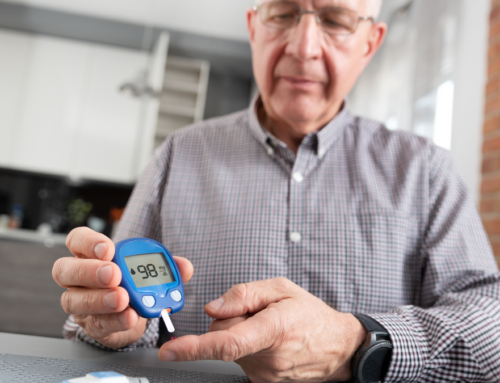
Aging gracefully is challenging enough under perfect circumstances, much less when struggling with a chronic condition. According to the National Council on Aging:
- Approximately 80% of older adults have at least one chronic disease, and 77% have at least two. Four chronic diseases—heart disease, cancer, stroke, and diabetes—cause almost two-thirds of all deaths each year.
- Chronic diseases account for 75% of the money our nation spends on health care, yet only 1% of health dollars are spent on public efforts to improve overall health.
- Diabetes affects 12.2 million Americans aged 60+, or 23% of the older population. An additional 57 million Americans aged 20+ have pre-diabetes, which increases a person’s risk of developing type 2 diabetes, heart disease, and stroke. In a 2007 Centers for Disease Control and Prevention program for people at high risk for developing diabetes, lifestyle intervention reduced risk by 71% among those aged 60+.
- 90% of Americans aged 55+ are at risk for hypertension, or high blood pressure. Women are more likely than men to develop hypertension, with half of women aged 60+ and 77% of women aged 75+ having this condition. Hypertension affects 64% of men aged 75+.
Here is an image provided by the National Council on Aging, identifying the Top 10 Chronic Conditions for Adults 65+.
Number 1: Hypertension (high blood pressure)
More than half of older adults are treated for high blood pressure, which is a condition that includes both how much blood your heart pumps, and how resistant your arteries are to the blood flow. When your heart pumps a lot of blood, but you have narrow arteries which restrict the flow, it causes high blood pressure. The danger is that you can have it for years and not even realize it, but it can lead to serious health conditions, such as strokes and heart attacks.
Things you can do to try to prevent, or reduce, high blood pressure include:
- Maintain a healthy weight. You can reduce blood pressure by losing just 10 pounds.
- Watch your stress level, and use stress management tools.
- Limit salt and alcohol intake.
- Exercise daily – follow your doctor’s recommendations, and find the activity you can do daily.
- Check your blood pressure regularly. With early detection, you can treat it sooner and help eliminate or prevent long-term risks.
Number 2: High cholesterol
Just below half of older adults were treated for high cholesterol. This is when your body has an excess of bad fats that build up on the walls of your arteries, causing them to clog, which can lead to heart disease.
Four ways you can help manage or prevent high cholesterol (outside of medication) are:
- Quit smoking and eliminate (excessive) alcohol consumption.
- Be sure to stay active every day.
- Maintain a healthy weight.
- Minimize saturated and trans fats in your diet.
Number 3: Arthritis
One-third of older adults are treated for arthritis – an inflammation of your joints, which causes pain and stiffness and is typically more common in women.
Here are some steps you can take to manage arthritis symptoms or delay its onset:
- Exercise 30 minutes/day at least 5 days/week. A balance of strength, cardio and stretching exercises (like yoga, for example) seems to be most helpful.
- Once again, maintain a healthy weight. If you are overweight, it puts more stress on your joints.
- Be sure to always support your back, legs and arms.
- Protect your joints to prevent injuries.
- Don’t smoke.
Number 4: Coronary heart disease
Coronary heart disease is caused by a build-up of plaque that narrows the arteries that lead to the heart. Narrow or blocked arteries decreases the amount of oxygen-rich blood delivered to the heart. This can cause other complications like blood clots, angina, or a heart attack.
Helpful habits include:
- Limit sugar and salt intake, and stay away from saturated and trans fats.
- Get 7-8 hours of sleep each night
- Watch your stress levels.
- Do regular cardio exercise
- Don’t smoke
- Speak with your doctor about major risk factors, like high blood pressure and high cholesterol.
Number 5: Diabetes
Diabetes occurs when your body is resistant to, or doesn’t produce enough, insulin. Insulin is what your body uses to get energy from food, and distribute it to your cells. When this doesn’t happen, you get high blood sugar, which can lead to complications such as kidney disease, heart disease, or blindness. Chances of having diabetes increases after age 45.
Your doctor may suggest some of the following to help manage, or reduce the risk of, diabetes:
- Eat a healthy diet and talk to your doctor about alcohol, carbohydrates, and sugar intake.
- Exercise for 30 minutes 5 days/week to maintain glucose levels and body weight.
- If you’re diagnosed with pre-diabetes, safely change your diet in order to lose excess weight and get down to a healthy level.
Number 6: Chronic kidney disease
Chronic Kidney Disease (CKD) is a slow loss in kidney function over time. People dealing with CKD have an increased risk for developing heart disease or kidney failure. Here is how you can lower your risk of CKD:
- Diabetes and high blood pressure are the greatest risk factors for kidney damage. Taking steps to prevent these diseases is an excellent strategy.
- Early detection and treatment. Talk to your doctor regularly, get screened regularly, and keep up on necessary prescriptions to reduce symptoms.
Number 7: Heart failure
Heart failure is a condition that occurs when the heart cannot adequately supply blood and oxygen to all of the organs in the body. The heart might become enlarged, develop more muscle mass, or pump faster in order to meet the body’s needs, causing you to feel tired, light headed, nauseous, confused, or lack an appetite. This is a serious risk and you should follow the advice of your doctor to both treat the symptoms and, more importantly, make the lifestyle changes necessary to lower your risk.
Number 8: Depression
Unfortunately, depression is becoming more and more prevalent amongst our aging community. It is considered a treatable medical condition and is not a normal part of aging. Depression causes persistent feelings of sadness, pessimism, hopelessness, fatigue, difficulty making decisions, changes in appetite, a loss of interest in activities, amongst other things.
Some steps to take to help with depression include:
- Manage stress levels. High stress can lead to depression.
- Eat a healthy diet. This is often overlooked, but a poor diet can adversely affect your mood and brain function.
- Daily exercise. Along with other healthy benefits, exercise releases endorphins, which are brain chemicals that help us feel better, happier, and more fulfilled.
- Talk to your doctor. If the situation is dire enough, there may be medications that can help regulate the feelings and help bring about a more balanced mood.
If you or someone you love has had thoughts of suicide, call the National Suicide Prevention Lifeline at 1.800.273.8255 (TALK).
Number 9: Dementia (Alzheimer’s disease)
Alzheimer’s Disease is one specific type of dementia—a condition that causes memory loss and difficulty thinking or problem-solving to the point that it interferes with daily activities. Dementia is not a normal part of aging and is caused by changes in the brain over time.
There are many factors leading to the risk of dementia, including family history, genetics, diet, etc. Some steps you can take to help ward off dementia are:
- Exercise. Staying active is good for your heart and your brain.
- Sleep. 7 to 8 hours of sleep per night helps the body heal and rejuvenate.
- Eat a healthy, balanced diet. This definitely impacts your body and brain function.
Number 10: Chronic obstructive pulmonary disease
Chronic Obstructive Pulmonary Disease (COPD) icludes two main conditions—emphysema and chronic bronchitis. COPD makes it hard to breathe and causes shortness of breath, coughing, and chest tightness.
- The number one way to prevent COPD—or slow it’s progression—is to quit or avoid smoking.
- If you already have COPD, be sure to follow the treatments prescribed by your doctor.
We hope you’ve found this information helpful. If you have specific questions or concerns about any of the conditions listed above, you should consult your physician first. If you or a loved one suffers from any of these conditions making it difficult to live on their own, we can help. Please reach out to us for a no-cost, no-obligation consultation. We will gladly review your situation with you and help you find the best solution that fits both your situation and your budget. Contact us through our website, or call us at (678) 494-8129.







Great content! Super high-quality! Keep it up! 🙂